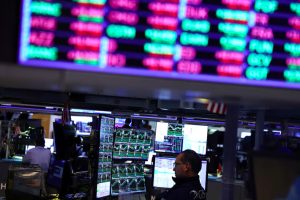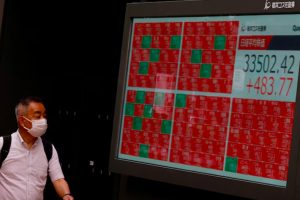Asia’s major stock indexes saw mixed fortunes on Tuesday with China’s continuing economic woes and Japan’s move to end eight years of negative interest rates having the most impact on investors.
China stocks fell, tracking regional markets lower, as worries over the country’s deepening property crisis and soft domestic demand offset signs of improvement in factory output.
But the headlines were stolen by the Bank of Japan as it shifted away from years of ultra-easy monetary policy. It also abandoned yield curve control and dropped purchases of riskier assets, including exchange-traded funds.
Also on AF: Evergrande Founder Banned, Unit Fined For Securities Fraud
Tokyo’s Nikkei index was choppy initially after the decision but closed higher, passing the historic 40,000 mark again, while Japanese government bond yields fell.
The Nikkei share average was up 0.66%, or 263.16 points, to close at 40,003.60, while the broader Topix was ahead 1.06%, or 28.98 points, to 2,750.97.
The yen weakened 0.78% to 150.29 per dollar, indicating the landmark pivot had already been priced into markets after weeks of policy clues and media reports that a shift was imminent.
Analysts expect the yen, which is extremely sensitive to US rates, to be more influenced by the Federal Reserve’s policy decisions as well as projections of the number of rate cuts this year by the US central bank.
Investor focus is now on whether the BOJ’s hike is a one-and-done move or if there is more tightening to come as it may influence the yen’s role as a funding currency for carry trades.
BOJ Governor Kazuo Ueda said in his press conference that accommodative financial conditions will be maintained for the time being and the pace of further hikes will depend on the economic and inflation outlooks.
China Real Estate Slips
China stocks fell despite data on Monday showing factory output and retail sales beat expectations in the January-February period, with weakness in the property sector remaining a heavy drag on the economy and confidence.
Caution ahead of a flurry of global central bank meetings this week also kept trading subdued, with the US Federal Reserve reviewing policy midweek amid further signs it may not cut interest rates as quickly or as much as expected just a few months ago, which would keep pressure on China’s yuan.
The blue-chip CSI300 Index lost 0.72% while the Shanghai Composite Index slipped 0.72%, or 22.17 points, to 3,062.76. The Shenzhen Composite Index on China’s second exchange retreated 0.43%, or 7.73 points, to 1,795.72.
Shares in healthcare, communications lost more than 1% each to lead the decline, while consumer staples and energy both added more than 1%.
Real estate developers slipped 0.4% even after Beijing’s city authority said it would optimise property regulation and implement different policies based on each district’s situation.
Tech giants listed in Hong Kong slumped 1.8% as the benchmark Hang Seng Index dropped 1.24%, or 207.64 points, to 16,529.48.
Elsewhere across the region, in earlier trade, markets were mixed as there were gains in Sydney, Singapore, Jakarta, Bangkok and Wellington, while Seoul, Mumbai, Taipei and Manila registered losses. MSCI’s broadest index of Asia-Pacific shares outside Japan fell 0.84%.
Aussie Dollar Drops
European bourses were looking at a lower open, with Eurostoxx 50 futures down 0.30%, German DAX futures down 0.29% and FTSE futures 0.32% lower.
Australia’s central bank held interest rates steady as expected, while watering down a tightening bias to just say that it was not ruling anything in or out on policy.
The Australian dollar slipped 0.63% to $0.6519 following the decision. The Aussie is down over 4% against the US dollar this year.
The Fed is widely expected to hold rates steady on Wednesday, with the market’s attention on policymakers’ updated economic and interest rate projections and comments from Chair Jerome Powell.
Last week’s stronger than expected inflation reports led traders to reduce their bets on rate cuts this year, with markets now pricing in 71 basis points (bps) of easing this year. At the start of the year, traders were pricing in 150 bps of cuts.
Traders are pricing in a 54.7% chance of the Fed starting its easing cycle in June, the CME FedWatch tool showed, sharply lower than earlier expectations.
The yield on benchmark 10-year Treasury notes eased to 4.324% in Asian hours, having risen to a three-week high of 4.348% on Monday. The elevated yields boosted the dollar, with its index touching a two-week high of 103.82.
In commodities, spot gold eased to $2,155.60 an ounce. US crude fell 0.18% to $82.57 per barrel and Brent was at $86.74, down 0.17% on the day.
Key figures
Tokyo – Nikkei 225 > UP 0.66% at 40,003.60 (close)
Hong Kong – Hang Seng Index < DOWN 1.24% at 16,529.48 (close)
Shanghai – Composite < DOWN 0.72% at 3,062.76 (close)
London – FTSE 100 < DOWN 0.05% at 7,718.93 (0935 GMT)
New York – Dow > UP 0.20% at 38,790.43 (Monday close)
- Reuters with additional editing by Sean O’Meara
Read more:
Bank of Japan Ends Negative Rates, as Ueda Normalises Policy
China Ups IPO Rules to Protect Investors With ‘Teeth And Horns’
Mainland Chinese Eye Hong Kong Property After Duties Ditched
Nikkei Surges on Weak Yen, Hang Seng Edges Ahead on Tech
























